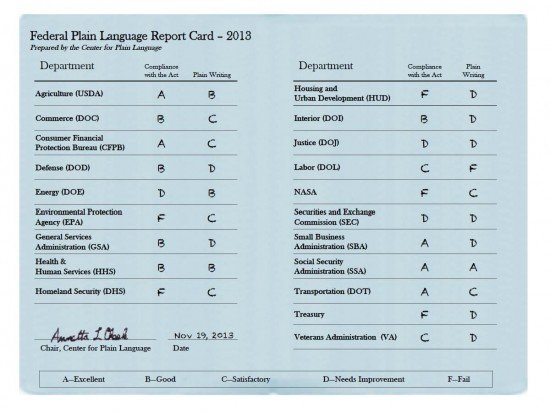And the Award for the Least Government Gibberish Goes To…

Clear writing is essential in business. Whether you are writing an email, memo, speech, or developing a presentation, it is vital that your intended audience be able to fully comprehend what you are trying to say the first time around, without having to wade through unnecessary and complicated language. More importantly, the ability to write clearly can have a significant effect on the bottom line. According to the book, Writing that Works by Kenneth Roman and Joel Raphaelson, the Veterans Benefits Administration saves $500,000 a year by training its employees to write clearly.
So what is clear writing and how can you tell if your writing could use some work? There are many different methods used to evaluate the clarity of written content. The most common is called the Flesch-Kincaid score. This score measures reading ease and comprehension difficulty using a formula to evaluate the total number of words, total number of sentences and total number of syllables used. Similar measurements include the Gunning Fog Index, the Simple Measure of Gobbledygook (SMOG), and the ATOS Readability Formula. They all use varying forms of algorithms to analyze the clarity of written text.
How does government communication compare? Despite the passage of the Plain Writing Act of 2010, which requires federal agencies to use clear communication that the public can understand, some of the most unclear writing can be found on government websites.
Each year a non-profit organization, The Center for Plain Language, evaluates 20 federal agencies on their compliance with the Act and publishes a report card showing how each agency performed. To evaluate the websites, The Center for Plain Language uses their own formula of 6 metrics that consider the complexity of words and the types of words used to determine a plain language grade. In 2013, 10 of the 20 agencies evaluated were given a plain language grade of D or F. Only one, the Social Security Administration, was given an A.
Because so many federal agencies were given failing scores, we decided to use our own Quantified Communications technology to gain further insight into how these agencies could improve the clarity of their written content.
Our process:
- We pulled text from the homepage of each of the 20 federal agencies.
- We also pulled text from each agency’s explanation of how it conforms to the Plain Writing Act.
- We used our Natural Language Processing and Linguistic Mapping technology to measure the language used.
- We benchmarked the language against our database of over 24,000 unique pieces of content including public policy statements, executive communications, and other website text.
Our findings:
- The top performers (those given grades of A or B by the Center for Plain Language):
- Score higher than average on Clarity
- Score lower than average on Flesch-Kinkaid Readability
- Use more personal pronouns than average
- Personal pronouns are important for clear writing as they provide context and can help the reader understand who the information pertains to. By directly addressing the reader as “you”, the content sounds more conversational and is easier to follow.
- The bottom performers (those with grades of D or F):
- Score lower than average on Clarity
- Score lower than average on Flesch-Kincaid Readability
- Use fewer personal pronouns than average
- Use fewer causation words (such as “therefore” and “because”) than average
- Causation words are important as they directly indicate how one idea is connected to another. By showing cause and effect, they help the writing to flow smoothly and help the reader comprehend multiple pieces of information easily.
In conclusion, our results generally agreed with those of the Center for Plain Language. Although measurements such as Flesch-Kincaid, which only take into account the complexity of words used, are a good start for evaluating message clarity, they are not complete. To ensure your writing is clear, start by thinking about the complexity of the words you choose, use personal pronouns to speak to your audience, and use causation words to link ideas together.